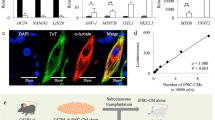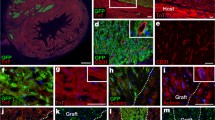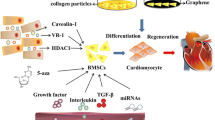Abstract
Cell transplantation shows potential for the treatment of cardiac diseases. Embryonic stem cells, cord blood and mesenchymal stem cells have been suggested as sources for transplantation therapy. Because of some technical limitations with the use of stem cells, transdifferentiation of fully differentiated cells is a potentially useful alternative. We investigated whether human peripheral blood cells could transdifferentiate into cardiomyocyte. Transdifferentiation was induced in a human B lymphocyte cell line (Raji). Cardiomyocyte extract was prepared from adult mouse cardiomyocytes. The cells were treated with 5-aza-2-deoxycytidine and trichostatin A, permeabilized with streptolysin O, and exposed to the mouse cardiomyocyte extract. They were cultured for 10 days, 3 weeks and 4 weeks. Cardiomyocyte markers were detected with immunohistochemistry and flow cytometry. Immunocytochemistry revealed that some cells expressed myosin heavy chain, α-actinin and cardiac troponin T after 3 and 4 weeks. Flow cytometry confirmed these data. In cells exposed to trichostatin A and 5-aza-2-deoxycytidine and permeabilized in the presence of the cardiomyocyte extract, troponin T expression was seen in 3.53% of the cells and 3.11% of them expressed α-actinin. After exposure to the cardiomyocyte extract, some permeabilized cells adhered to the plate loosely; however, the morphology did not change significantly, and they continued to show a rounded shape after 4 weeks. Our treated lymphocytes expressed cardiomyocyte markers. Our results suggest that lymphocytes may be useful in future research as a source of cells for reprogramming procedures.






Similar content being viewed by others
References
Shunsuke O, Hajime O, Soichiro K, Noritoshi N. Mesenchymal stem cells for the treatment of heart failure. Int J Hematol. 2007;86:17–21.
Nagaya N, Kangawa K, Itoh T, et al. Transplantation of mesenchymal stem cells improves cardiac function in a rat model of dilated cardiomyopathy. Circulation. 2005;112:1128–35.
Davies B, Elwood NJ, Li S, et al. Human cord blood stem cells enhance neonatal right ventricular function in an ovine model of right ventricular training. Ann Thorac Surg. 2010;89:585–93.
He Q, Trindade PT, Stumm M, et al. Fate of undifferentiated mouse embryonic stem cells within the rat heart: role of myocardial infarction and immune suppression. J Cell Mol Med. 2009;13:188–201.
Chen YR, Li Y, Chen L, Yang XC, Su PX, Cai J. The infarcted cardiac microenvironment cannot selectively promote embryonic stem cell differentiation into cardiomyocytes. Cardiovasc Pathol. 2010;123:979–83.
Catalucci D, Bang ML, Condorelli G. Deciphering the beta-adrenergic response in human embryonic stem cell-derived-cardiac myocytes: closer to clinical use? Br J Pharmacol. 2008;153:625–6.
Toma C, Pittenger MF, Cahill KS, et al. Human mesenchymal stem cells differentiate to a cardiomyocyte phenotype in the adult murine heart. Circulation. 2002;105:93–8.
Xu W, Zhang X, Qian H, et al. Mesenchymal stem cells from adult bone marrow differentiation into a cardiomyocyte phenotype in vitro. Exp Biol Med. 2004;229:623–31.
Antonitsis P, Ioannidou-Papagiannaki E, Kaidoglou A, Papakonstantinou C. In vitro cardiomyogenic differentiation of adult human bone marrow mesenchymal stem cells. The role of 5-azacytidine. Interact Cardiovasc Thorac Surg. 2007;6:593–7.
Labovsky V, Hofer EL, Feldman L, et al. Cardiomyogenic differentiation of human bone marrow mesenchymal cells: role of cardiac extract from neonatal rat cardiomyocytes. Differentiation. 2009;79:93–101.
Gaustad KG, Boquest AC, Andersone BE, Gerdes AM, Collas P. Differentiation of human adipose tissue stem cells using extracts of rat cardiomyocytes. Biochem Biophys Res Commun. 2004;314:420–7.
Badorff C, Brandes RP, Popp R, et al. Transdifferentiation of blood derived human adult endothelial progenitor cells into functionally active cardiomyocytes. Circulation. 2003;107:1024–32.
Rajasingh J, Lambers E, Hamada H, et al. Cell-free embryonic stem cell extract-mediated derivation of multipotent stem cells from NIH3T3 fibroblasts for functional and anatomical ischemic tissue repair. Circ Res. 2008;102:107–17.
Neri T, Monti M, Rebuzzini P, et al. Mouse fibroblasts are reprogrammed to Oct-4 and Rex-1 gene expression and alkaline phosphatase activity by embryonic stem cell extracts. Cloning Stem Cells. 2007;9:394–406.
Choi KS, Shin JS, Lee JJ, Kim YS, Kim SB, Kim CW. In vitro trans-differentiation of rat mesenchymal cells into insulin-producing cells by rat pancreatic extract. Biochem Biophys Res Commun. 2005;330:1299–305.
MacDonald JL, Roskams AJ. Epigenetic regulation of nervous system development by DNA methylation and histone deacetylation. Prog Neurobiol. 2009;88:170–83.
Tada T. Toti-pluripotential stem cells and epigenetic modifications. Neurodegener Dis. 2006;3:32–7.
De Boer J, Licht R, Bongers M, van der Klundert T, Arends R, van Blitterswijk C. Inhibition of histone acetylation as a tool in bone tissue engineering. Tissue Eng. 2006;12:2927–37.
Kiziltepe T, Hideshima T, Catley L, et al. 5-Azacytidine, a DNA methyltransferase inhibitor, induces ATR-mediated DNA double-strand break responses, apoptosis, and synergistic cytotoxicity with doxorubicin and bortezomib against multiple myeloma cells. Mol Cancer Ther. 2007;6:1718–27.
Shenoi BV. In vitro lymphocyte-to-granulocyte transdifferentiation induced by chemicals. Curr Sci. 2004;87:491–4.
Szilvassy SJ. The biology of hematopoietic stem cells. Arch Med Res. 2003;34:446–60.
Wu D, Hamilton B, Martin C, Gao Y, Ye M, Yao S. Generation of induced pluripotent stem cells by reprogramming human fibroblasts with the stemgent human TF lentivirus set. J Vis Exp. 2009;34:pii 1553. doi:10.3791/1553.
Takahashi K, Yamanaka S. Induction of pluripotent stem cells from mouse embryonic and adult fibroblast cultures by defined factors. Cell. 2006;126:663–76.
Aasen T, Belmonte JC. Isolation and cultivation of human keratinocytes from skin or plucked hair for the generation of induced pluripotent stem cells. Nat Protoc. 2010;5:371–82.
Håkelien AM, Gaustad KG, Collas P. Transient alteration of cell fate using a nuclear and cytoplasmic extract of an insulinoma cell line. Biochem Biophys Res Commun. 2004;9:834–41.
Xu YN, Guan N, Wang ZD, et al. ES cell extract-induced expression of pluripotent factors in somatic cells. Anat Rec (Hoboken). 2009;292(8):1229–34.
Gai H, Leung EL, Costantino PD, et al. Generation and characterization of functional cardiomyocytes using induced pluripotent stem cells derived from human fibroblasts. Cell Biol Int. 2009;33:1184–93.
Zhao J, Hao Y, Ross JW, et al. Histone deacetylase inhibitors improve in vitro and in vivo developmental competence of somatic cell nuclear transfer porcine embryos. Cloning Stem Cells. 2010;12:75–83.
Cervera RP, Martí-Gutiérrez N, Escorihuela E, Moreno R, Stojkovic M. Trichostatin A affects histone acetylation and gene expression in porcine somatic cell nucleus transfer embryos. Theriogenology. 2009;72:1097–110.
Zhang XM, Li QM, Su DJ, et al. RA induces the neural-like cells generated from epigenetic modified NIH/3T3 cells. Mol Biol Rep. 2010;37:1197–202.
Kablar B, Krastel K, Tajbakhsh S, Rudnicki MA. Myf5 and MyoD activation define independent myogenic compartments during embryonic development. Dev Biol. 2003;258:307–18.
Kaminski R, Kozar K, Niderla J, et al. Demethylating agent 5-aza-2′-deoxycytidine enhances expression of TNFRI and promotes TNF-mediated apoptosis in vitro and in vivo. Oncol Rep. 2004;12(3):509–16.
Sigalotti L, Altomonte M, Colizzi F, et al. 5-Aza-2′-deoxycytidine (decitabine) treatment of hematopoietic malignancies: a multimechanism therapeutic approach? Blood. 2003;101:4644–6.
Wernig G, Janzen V, Schäfer R, et al. The vast majority of bone-marrow-derived cells integrated into mdx muscle fibers are silent despite long-term engraftment. Proc Natl Acad Sci USA. 2005;102:11852–7.
Champion C, Guianvarc’h D, Sénamaud-Beaufort C, et al. Mechanistic insights on the inhibition of c5 DNA methyltransferases by zebularine. PLoS One. 2010;5:e12388.
Iwatani M, Ikegami K, Kremenska Y, et al. Dimethyl sulfoxide has an impact on epigenetic profile in mouse embryoid body. Stem Cells. 2006;24:2549–56.
Kehat I, Kenyagin-Karsenti D, Snir M, et al. Human embryonic stem cells can differentiate into myocytes with structural and functional properties of cardiomyocytes. J Clin Invest. 2001;108:407–14.
Acknowledgments
The authors thank the Vice-Chancellor for research of the Shiraz University of Medical Sciences for support through grant no. 88-4578, and Ms L. Rohani for excellent technical support. We also thank K. Shashok (Author AID in the Eastern Mediterranean) for improving the use of English in the manuscript, and M. Gholami at the Center for Development of Clinical Research of Nemazee Hospital for research assistance. This study formed part of the work done by S. Tavakolinejad for a thesis.
Author information
Authors and Affiliations
Corresponding author
Rights and permissions
About this article
Cite this article
Vojdani, Z., Tavakolinejad, S., Talaei-Khozani, T. et al. Cardiomyocyte marker expression in a human lymphocyte cell line using mouse cardiomyocyte extract. Human Cell 24, 35–42 (2011). https://doi.org/10.1007/s13577-011-0009-0
Received:
Accepted:
Published:
Issue Date:
DOI: https://doi.org/10.1007/s13577-011-0009-0




